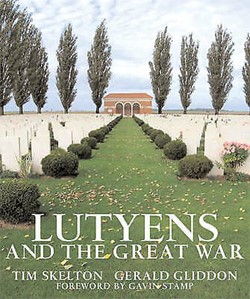Sir Edwin Lutyens and The Great War - Cemeteries and Memorials

Lutyens and The Great War
Tim Skelton and Gerald Gliddon
2008
ISBN 9780711228788
London: Frances Lincoln
98 Books about Poland | Polish War Graves in Britain
Sir Edwin Lutyens was one of the principal architects of the cemeteries and memorials of the First World War.
He was commissioned by the Imperial War Graves Commission (now Commonwealth War Graves Commission) to design many of the cemeteries and memorials to the missing on the Western Front.
The War Stone
Lutyens put forward the idea that the cemeteries should contain a War Stone - a Stone of Remembrance.
On platforms made of not less than 3 steps the upper and the lower steps of a width twice that of the centre step: to give due dignity: place one great stone of fine proportion 12 feet long ... (p. 24)
The CWGC records that cemeteries with over 1,000 burials have a Stone of Remembrance designed by Lutyens. The Stone has upon it a short inscription with words from Ecclesiasticus 44:14:
Their Name Liveth For Evermore
The Cross of Sacrifice
If a cemetery contains more than 40 graves it will have a Cross of Sacrifice which was designed by the architect Reginald Blomfield. The Cross features a bronze sword attached to an octagonal shaft.
... one of the enduring images of the Western Front today is of the smaller cemeteries in the middle of the fields identifiable by the Cross. (p. 119)
The Graves
The individual graves are marked by a uniform headstone. These are distinguished by their inscriptions which contain the following:
- National emblem or regimental badge
- Rank
- Name
- Unit
- Date of death
- Age
- Appropriate religious symbol
- Personal dedication chosen by relatives
The Entrance
The entrance to the cemeteries can be simple:
... just a pair of entrance piers with the cemetery name carved into the stonework but it will often be combined with bronze gates that give a satisfying clunk as they are closed ... (p. 116)
... or it can be grand with the entrance to the cemetery being through a shelter building.
It is these buildings, where they are provided, that can give the cemeteries their uniqueness. In general ... a classical style ... the variety of designs of the buildings is bewildering. (p. 119-120)
The shelter buildings are mostly found in the larger cemeteries.
Horticulture
The planting in the cemeteries can resemble an English country garden.
Sir Edwin Lutyens had worked closely with the horticulturist Gertrude Jekyll, whose devotion to traditional cottage garden plants and roses greatly influenced the appearance of the cemeteries. (Source: CWGC)
The Cemeteries
There are over 900 cemeteries along the Western Front from the French border with Switzerland to the North Sea. The largest cemetery is at Tyne Cot and contains nearly 12,000 graves. Some of the smaller cemeteries have less than 50 burials.
Whilst the sheer scale of Tyne Cot ensures that any visit to it is a moving experience, it is through the sheer number of cemeteries and their variation in sizes that one experiences a greater sense of the War's real tragedy. (p. 107)
The number of cemeteries that Lutyens was involved in designing was 137.
The Lutyens and The Great War book contains photographs of the cemeteries Lutyens designed and notes the number of casualties buried in each cemetery. The authors consider that the key cemeteries in which to see the best of Lutyen's work on the Western front are the following:
- Monchy British Cemetery (581 casualties)
- La Neuville British Cemetery (866 casualties)
- Béthune Town Cemetery (3,004 casualties)
- Dernancourt Communal Cemetery Extension (2,162 casualties)
- Vailly British Cemetery (675 casualties)
- Croisilles British Cemetery (1,171 casualties)
- H.A.C. Cemetery (1,832 casualties)
- Serre Road Cemetery No. 2 (7,126 casualties)
- Bagneux British Cemetery (1,374 casualties)
- Etaples Military Cemetery (10,761 casualties)
Etaples is the largest war cemetery in France and the largest designed by Lutyens. The authors of the book suggests this cemetery is pure theatre and not to be missed.
Memorials to the Missing
There were 517,000 known to have died in the Great War whose bodies either could not be found or, if they were found, could not be identified. The unknown bodies were buried in graves with headstones inscribed with the words:
A Soldier of the Great War Known Unto God
If a regiment was identified from the soldier's uniform then this information was added to the headstone.
For those soldiers who could not be found it was proposed that their names be listed on a number of Memorials to the Missing. Sir Edwin Lutyens was asked to design the Thiepval Memorial - the Memorial to the Missing of the Somme. This memorial is the largest British war memorial in the world. The names of 72,099 missing are inscribed upon it.
Sir Edwin Lutyens
Before the First World War Sir Edwin Lutyens designed a number of large houses for wealthy clients. He designed the house at Munstead Wood (1896) for his friend and collaborator, Gertrude Jekyll, the garden designer.
Sir Edwin Lutyens was responsible for the design of the Cenotaph in Whitehall, London. He also designed numerous other war memorials located in towns and cities in the United Kingdom.
Born 9 March 1869 - Died 1 January 1944.
Related Material
 Great Lives Edwin Lutyens, BBC Radio 4, iPlayer broadcast in September 2011
Great Lives Edwin Lutyens, BBC Radio 4, iPlayer broadcast in September 2011- The Great War 1914-1918
 A History of the Cenotaph (London), BBC, 14 November 2010, Video with Tim Skelton explaining why the Cenotaph became such a focal point for people.
A History of the Cenotaph (London), BBC, 14 November 2010, Video with Tim Skelton explaining why the Cenotaph became such a focal point for people.